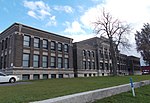ALT Theatre
ALT Theatre is an American theater company founded in 2007, that has been noted as a leader of ground-breaking new works in contemporary theatre and dance. The company is dedicated to producing new contemporary-style plays that involve not only the traditional theatre elements, but also elements in media and contemporary dance. Located at 255 Great Arrow Avenue in Buffalo, New York, the ALT Theatre provided an intimate blackbox setting and makes the theatre experience more inviting and accessible. Multiple different performances have taken place at the theatre, including aerial dances.The ALT Theatre's productions have been nominated for multiple Artie awards over the years, winning in 3 categories.
Excerpt from the Wikipedia article ALT Theatre (License: CC BY-SA 3.0, Authors).ALT Theatre
Great Arrow Avenue, Buffalo
Geographical coordinates (GPS) Address Nearby Places Show on map
Geographical coordinates (GPS)
| Latitude | Longitude |
|---|---|
| N 42.942222222222 ° | E -78.876388888889 ° |
Address
Great Arrow Avenue 255
14207 Buffalo
New York, United States
Open on Google Maps









